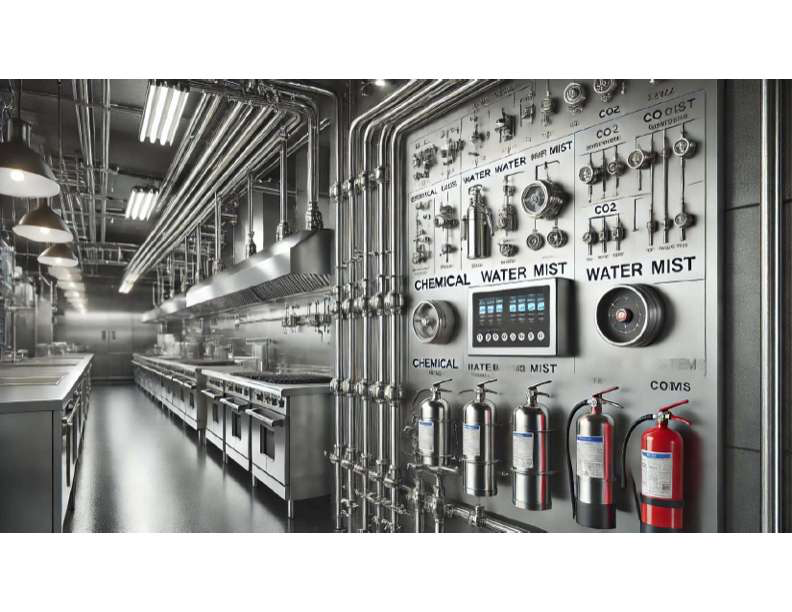Fire suppression systems in commercial kitchens are essential for safety and regulatory compliance. These systems are specifically designed to address the unique fire risks posed by cooking appliances and grease-laden environments. The most popular types of fire suppression systems for commercial kitchens include:
1. Wet Chemical Fire Suppression Systems
- Overview: The most widely used system in commercial kitchens, wet chemical systems are specifically designed to handle grease fires.
- How It Works: They release a potassium-based chemical that reacts with grease to form a soap-like substance (saponification), cutting off oxygen and cooling the fire.
- Key Features:
- Effective for fires involving Class K (cooking oils and fats).
- Automatically activated by heat sensors but can also be triggered manually.
- Commonly installed in the hoods and ductwork over cooking appliances.
- Popular Brands: Ansul R-102, Pyro-Chem Kitchen Knight II, and Kidde WHDR.
2. CO₂ Fire Suppression Systems
- Overview: Carbon dioxide systems are used in some kitchen environments but are less common due to their lack of suitability for grease fires.
- How It Works: CO₂ displaces oxygen, suffocating the fire.
- Key Features:
- Ideal for non-grease fire risks (e.g., electrical equipment in kitchens).
- Not safe for occupied spaces due to the risk of suffocation.
3. Foam Fire Suppression Systems
- Overview: Foam-based systems are sometimes used in conjunction with wet chemical systems.
- How It Works: Foam suppresses fires by cooling and forming a barrier between the fuel and oxygen.
- Key Features:
- Effective for Class K fires and certain other fire classes.
- Often used for added fire safety in specific high-risk zones.
4. Water Mist Fire Suppression Systems
- Overview: A relatively newer technology, water mist systems use fine water droplets to suppress fires.
- How It Works: The fine mist cools the fire and displaces oxygen by creating steam.
- Key Features:
- Environmentally friendly and safe for occupied spaces.
- Less effective against grease fires compared to wet chemical systems.
5. Dry Chemical Fire Suppression Systems
- Overview: These systems use a dry powder to suppress flames but are rarely used in modern commercial kitchens due to their messiness and inefficiency with grease fires.
- How It Works: Dry chemical agents coat the fuel, cutting off oxygen and preventing re-ignition.
- Key Features:
- Effective for general Class A, B, and C fires.
- Not recommended for grease-heavy environments due to residue and re-ignition risks.
6. Automatic Sprinkler Systems
- Overview: Often used in combination with other suppression systems, sprinklers provide general fire protection for the entire facility.
- How It Works: Sprinklers activate when the heat reaches a certain temperature, spraying water to extinguish the fire.
- Key Features:
- Provides wide-area protection.
- Ineffective for grease fires unless combined with Class K extinguishing agents.
Key Considerations When Choosing a System
- Compliance: Must meet local fire codes and NFPA (National Fire Protection Association) standards, such as NFPA 96.
- Size of Kitchen: Larger kitchens may require more complex systems.
- Type of Cooking Equipment: Systems must be compatible with grills, fryers, ovens, and other appliances.
- Maintenance: Regular inspections and maintenance are required for most systems to remain operational and compliant.
Wet chemical systems remain the gold standard for commercial kitchens due to their targeted effectiveness against grease fires, ease of integration, and compliance with safety standards.

